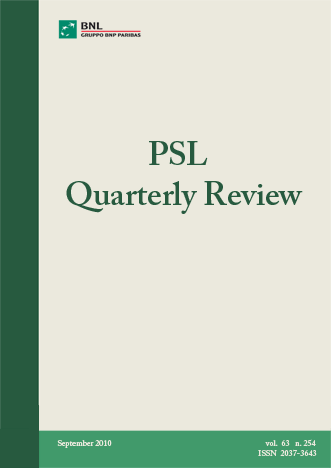Macroeconomic trends and reforms in Germany
DOI:
https://doi.org/10.13133/2037-3643/9428Keywords:
macroeconomy, productivity, reform, GermanyAbstract
This paper traces the main macroeconomic developments in the German economy from national unification. Its performance is compared with that of the rest of the euro area and its largest economies. The study documents as Germany’s modest growth in the later 1990s was due to the restrictive impact on domestic demand coming from the deep restructuring and modernization of the production system, followed by sweeping reforms after the turn of the century. Rapid productivity increases and prolonged wage moderation, especially in industry, fuelled a large and mounting current account surplus in Germany, that compares with the deficits registered in most European countries. The study retraces the recent debate on how to correct those imbalances, recalling the arguments for and against the thesis that the countries with a current payments surplus, above all Germany, must also play an active role in fostering the adjustment of the deficit countries. A possible synthesis is proposed, based on an analysis of the formation of national income and the use of resources according to the national accounts system. The implication is that Germany may contribute to the correction of imbalances within the euro area not so much by altering the wage formation mechanism as by creating incentives for domestic investment, hence fostering employment creation, in the service sectors that are currently lagging behind the extraordinary perfomance of a number of core activities in the industry.
JEL Codes: E20, E61, O52
References
BANCA D’ITALIA, Relazione annuale, various years.
BRUNNER A., DECRESSIN J., HARDY D. and KUDELA B. (2004), “Germany’s Three-Pillar Banking System – Cross-Country Perspectives in Europe”, Occasional Paper, n. 233, Washington (DC): International Monetary Fund.
CARLIN W. and SOSKICE D. (2009), “German economic performance: disentangling the role of supply-side reforms, macroeconomic policy and coordinated institutions”, Socio-Economic Review, October.
DEUTSCHE BUNDESBANK (2006), “German foreign direct investment (FDI) relationships: recent trends and macroeconomic effects”, Monthly report, September.
DEUTSCHE BUNDESBANK (2007), “Private consumption in Germany since reunification”, Monthly report, September.
DEUTSCHE BUNDESBANK (2010), “On the problems of macroeconomic imbalances in the euro area”, Monthly report, July.
EUROPEAN COMMISSION (2002), “Germany’s economic performance in the 1990s”, European Economy Economic Paper, n. 170, Brussels: Directorate general for Economic and Financial Affairs.
EUROPEAN COMMISSION (2006), “Adjustment dynamics in the euro area: experiences and challenges”, European Economy, Directorate general for Economic and Financial Affairs.
EUROPEAN COMMISSION (2002), “Germany’s growth performance in the 1990’s”, European Economy, Directorate General for Economic and Financial Affairs, No. 170, May.
EUROPEAN COMMISSION (2007), “Country-study: raising Germany’s growth potential”, European Economy, Directorate General for Economic and Financial Affairs, No. 28, February.
GSOEP (2008) A quarter century of change: results from the German socio economic panel, DIW – Berlin.
HÜFNER F. (2010), The German Banking System: Lessons from the Financial Crisis, Paris: Oecd Economics Department.
MAGNANI M. (2008), Lo stato del processo di riforma del mercato del lavoro in Germania, Banca d’Italia, mimeo.
MARTINEZ OLIVAL J.C. (2008), Riunificazione intertedesca e politiche per la convergenza, Banca d’Italia, mimeo.
OECD (2010), Going for growth, Paris: OECD.
WEBER A. (2010), “Challenges and opportunities for the competitiveness of EMU member states”, Presentation at the Copenhagen Business School, 22 March.
WYPLOSZ C. (2010), “Germany, current accounts and competitiveness”, VoxEU.org, 31 March.
Downloads
Published
How to Cite
Issue
Section
License



